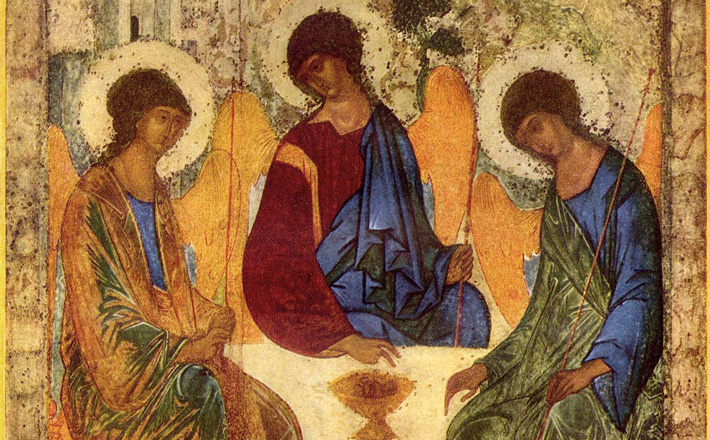Commentary on Genesis 1:1—2:4a
Genesis 1 traditionally appears on Holy Trinity Sunday, doubtlessly because interpreters have long understood portions of the text as allusions to the Trinity.
Luther, for example, believed the “Spirit of God” (RSV)1 in verse 2 represented the Holy Ghost:
“So also the Christian Church agrees that in this description there is indicated the mystery of the Holy Trinity. The father created through the Son, whom Moses calls the Word; and over this (creative) work brooded the Holy Spirit…”2
Indeed, that interpretation of the brooding spirit of God (rua?’elohîm) reaches back to the Patristics.3
Similarly, ancient interpreters regarded the presence of the first-person plural in verse 26 (“Let us make humankind in our image”) as evidence of the Triune God. Both Gregory of Nyssa and Chrysostom understood the “let us” as a divine deliberation among the persons of the Trinity.4 Luther also heard a revelation of the Trinity in the phrase:
“Again, the words, “Let us make man” confirm the mystery of our Christian faith, namely, that there is one eternal God, in whose divine essence there are three distinct persons: God the Father, Son, and Holy Ghost.”5
Naturally, other interpretations are possible. Many have understood the first-person plural as a reflection of God’s conversation with members of the heavenly court (see 1 Kings 22:19; Job 1:6 — 2:1-2, 38:7; and, possibly Isaiah 6:8). Others have seen the plural as a means to distance human semblance from that of God or as a way to signal that God is not actually revealing God’s self as God might by the use of a first person singular address. Westermann dismissed all of these interpretations, and instead understood the grammatical construction “let us make” as a plural of self-deliberation. Although he acknowledged that a heavenly court might be in the historical background, he maintained that the Priestly writer would not have countenanced such an image. He concluded, “The plural of deliberation in the cohortative is an attested and sufficient explanation.”6
Obviously, the interpretation of verse 26 is not settled. Depending on one’s understanding of the inspiration of Scripture, one can envision the Triune God permeating the creation account. Admittedly, this is a bit of an obstacle for those of us trained in the historical critical method.
Nevertheless, we should take a clue from the patristic fathers. Marius Victorinus, Prudentius, Augustine, and many more saw in Genesis 1:26 a reflection of the Trinity.7 The early fathers had no difficulty relating the eternal Word of John 1:1-3 to the word that God speaks in Genesis 1. Indeed, John’s Logos hymn cries out for just such a bridge, as does Hebrews 1:3. Doctrinally, the connection cannot be gainsaid: the eternal Triune God was fully present in the creation of the cosmos. The Athanasian Creed, traditionally recited on Holy Trinity Sunday, is clear on this point.
Yet, even if that connection and this text should happen to stir up an appreciation for this doctrinal mystery of the Christian faith (as it seems to have done for Luther), it is difficult to see how that might help most contemporary believers navigate their faithful way from Holy Trinity Sunday to Pentecost 2 a scant week later.
The Christian preacher’s task, moreover, is not to fashion a homiletical proof of the Trinity nor even an appreciation of it, but rather to profess the love of God in Christ.
One way to proclaim that divine love may be through a counterintuitive focus on that object of divine consideration described in verses 28 and 27, namely, the human being. Again, interpretations of what being created “in the image of God” (be?elem ’elohîm, Greek eikon theou) might mean vary wildly. Given the charge of dominion over the creation in verses 28 to 30, however, the suggestion of von Rad remains helpful. Von Rad reminded us that just as ancient kings erected images of themselves in portions of their reign where they did not actually appear, “so man is placed upon the earth in God’s image as God’s sovereign emblem.”8 As such, the human being, both male and female, serves as “God’s representative, summoned to maintain and enforce God’s claim to dominion over the earth.”9
As “image of God,” Christians are summoned to reflect God’s care for the world of creation and for human community. In that calling, we have an example and a model in Jesus, the quintessential image of God.
The Scriptures frequently remind us that, if we would see God, we must contemplate Christ Jesus. Jesus is the complete eikon theou, “the image of God (2 Corinthians 4:4), and “the image of the invisible God, the first-born of all creation” (Colossians 1:15). Jesus is the human being as God intended all human beings to be “in the beginning,” a perfect representation of God to the cosmos.
We are not now perfect representations of the image of God. The good news, however, is that God has already determined who and what we shall be. God has declared that we are “predestined to be conformed to the image of his Son” (Romans 8:29). We are slated to “bear the image of the man of heaven” (1 Corinthians 15:49). We who trust in Jesus, in spite of our imperfection and sin, can live in the confidence that we, “with unveiled faces, seeing the glory of the Lord as though reflected in a mirror, are being transformed into the same image from one degree of glory to another; for this comes from the Lord, the Spirit” (2 Corinthians 3:18). Because of Christ, our new selves are being “renewed in knowledge according to the image of its creator” (Colossians 3:10).
None of this happens by our own understanding or strength. God has determined that we will be reshaped into the image of God, as God intended us to be from the sixth day of creation. God has determined that we will participate in the community that is the Trinity, that we all may be one with each other and that, as Jesus prayed, we may be in community with the Triune God (John 17:21).
Male and female, sinner and saint, God has decided to reshape us, to recreate us, into Christ’s perfect relationship with God. In some way beyond our imagining, we will participate in the relationship of the Trinity and thus in the life of God. We are not there yet, but God promises that — whatever our failings — thus we shall be.
Notes:
1. The NRSV translation of “a wind from God,” is grammatically possible and finds a conceptual parallel in the Priestly writer’s Genesis 8:1 (see Exodus 15:10; Numbers 11:31). The “wind from God” may anticipate the division of the chaos waters in verses 9-10. On the other hand, the expression spirit of God (rua? ’elohîm)) appears in connection with some pneumatic emanation sent from God. In Exodus 31:3 and 35:31, the spirit of God inspires Bezalel’s artisanship. Frequently, the spirt of God is associated with prophetic behavior (Genesis 41:38; Numvers 24:2; 1 Samuel 19:20, 23; 2 Chronicles 15:1), although Saul was plagued by an “spirit of God” that was described as evil: 1 Samuel 16:15, 16, 23; 18:10. English translations are divided on the matter.
2. Martin Luther, Luther’s Commentary on Genesis, translation by J. Theodore Mueller (Grand Rapids: Dervan, 1958), 11.
3. Andrew Louth, ed., Ancient Christian Commentary on Scripture: Genesis 1-11, volume 1 (Downer’s Grove, IL: Inter-Varsity Press, 2000), 5-6.
4. Louth, Ancient Christian Commentary on Scripture: Genesis 1-11, 28.
5. Luther, Luther’s Commentary on Genesis, 28.
6. Claus Westermann, Genesis: A Commentary, vol. 1, trans. Bu John J. Scullion (Minneapolis: Augsburg, 1984), 145.
7. Louth, Ancient Christian Commentary on Scripture: Genesis 1-11, 29-31.
8. Gerhard von Rad, Genesis: A Commentary, revised edition (Philadelphia, PA: Westminster, 1973), 60.
9. Ibid.


June 11, 2017